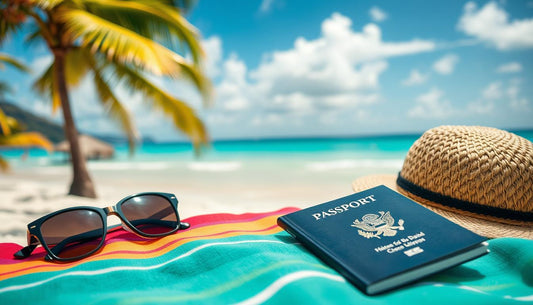Thailand welcomes travelers all year with its diverse landscapes and vibrant culture. Depending on where you go, the weather can vary, offering unique experiences in different seasons.
The ideal time to explore this beautiful country is between November and April. During these months, temperatures range from 84°F to 97°F, creating perfect conditions for sightseeing and beach adventures.
If you love underwater exploration, the west coast shines from November to February. Clear waters make diving and snorkeling unforgettable. For those who prefer fewer crowds, June offers cultural festivals and a more relaxed atmosphere.
With over 25 years of travel expertise, we know Thailand’s hidden gems. Whether you seek sunny beaches or cultural wonders, there’s always a great time visit.
When Is the Best Month to Visit Thailand?
Thailand’s diverse climate means every season offers something special. Whether you seek sunny beaches or cultural festivals, timing your trip ensures the best experience.
Dry Season (November–April): Ideal Weather
The dry season brings sunny days and little rain, perfect for island hopping. From November to February, the Andaman Coast shines with calm seas, ideal for snorkeling. Temperatures hover between 88°F and 91°F.
Inland, Bangkok enjoys warm weather (87–89°F), while Chiang Mai’s nights cool to 55°F. April heats up, hitting 104°F in central regions—pack light clothing!
Shoulder Seasons (April–June, September–October): Fewer Crowds
For quieter days, visit during shoulder seasons. Hotels drop rates by 30–50%, and popular spots like Phuket feel more relaxed. Ferry services to small islands may reduce, so check schedules.
September offers Gulf Coast deals with intermittent sun—great for budget travelers. Whether you prioritize savings or serenity, these months deliver.
Thailand’s Weather by Region
From misty mountains to tropical shores, Thailand’s weather varies widely. Where you go determines what you’ll pack—and the adventures you’ll have.
Northern Thailand: Cool Nights, Hot Days
Chiang Mai and Pai offer crisp mornings, especially in winter. Nights dip to 55°F, while daytime temperatures soar to 95°F by May. March–May brings the hottest days, perfect for temple hikes before noon.
Central Thailand: Sweltering Urban Heat
Bangkok and Ayutthaya bake under 97°F averages in April. Humidity hits "extreme" levels by May—lightweight clothes are a must. Evenings provide slight relief, but air conditioning feels essential.
Andaman Coast: Dual Monsoon Magic
The west coast (Phuket, Krabi) sees heavy rain from September–October. Expect 15–22 wet days monthly. Yet, Khao Sok National Park glows emerald green, ideal for jungle treks.
Gulf Coast: Island Paradise Timing
Koh Samui and Koh Phangan enjoy drier weather on the east coast. February has just 2 rainy days, while September brings brief showers. Hua Hin defies trends with its own rainfall pattern.
Worst Times to Visit Thailand
Not every period in Thailand guarantees sunny skies and smooth travels. While the country shines year-round, some months bring weather extremes that could dampen your plans.
Rainy Season (May–October): Heavy Showers
The rainy season sweeps across Thailand, with downpours peaking from July to September. Coastal areas like Phuket see 18 wet days monthly, and ferry services often cancel trips. Roads to Khao Sok National Park may close due to flooding.
Silver lining? Luxury resorts slash prices—5-star stays drop 60% in Phuket. Flights in July/August cost 40% less than December. Koh Samui bucks the trend with drier weather on the east coast.
Hot Season (March–May): Extreme Heat
March to May marks the hot season, where temperatures in Bangkok and Ayutthaya hit 104°F. Humidity makes it feel like a sauna. Pack lightweight clothes and plan indoor activities for midday.
Northern cities like Chiang Mai fare slightly better, but even there, April is scorching. If you brave this time, hydrate relentlessly and book hotels with strong air conditioning.
Festivals and Events to Plan Around
Thailand's vibrant festivals transform ordinary trips into unforgettable adventures. These celebrations showcase the country’s rich culture, drawing people from across the globe. Timing your travel around these events lets you dive into traditions you’ll cherish forever.
Chinese New Year: January/February
Bangkok’s Chinatown bursts with color during Chinese New Year. Over 500,000 visitors pack the streets for dragon dances and fireworks. Hotels book up six months ahead, so plan early.
Pair the festivities with beach days in Hua Hin or Krabi. Transportation surcharges apply, but the energy is worth it. Pro tip: Try *khao chae* (iced rice), a festive dish locals love.
Songkran: April 13–15
Songkran, the Thai New Year, turns the country into a giant water fight. Chiang Mai’s old city offers the most authentic experience—think flower parades and Buddha statue baths.
April’s heat is no match for the fun! Just pack a waterproof phone case. Smaller towns like Pai keep the celebrations lively but less chaotic.
This is the perfect time to join locals in washing away bad luck. Stay hydrated—water guns aren’t the only reason you’ll get wet!
Unlimited Data eSIM from RAPIDeSIM
The eSim thailand solution is becoming increasingly popular for travelers thanks to its simplicity and fast activation. Instead of inserting a physical SIM card, you can activate your plan instantly by scanning a QR code. It's compatible with most newer smartphones including iPhone 13 and up, as well as recent Samsung Galaxy models.
You can check if your device supports eSIM via our Compatibility Checker.
Why choose an eSIM for Mexico?
- Instant activation without visiting a store
- No need to remove your current SIM
- Flexible prepaid data plans tailored for tourists
- Strong 4G/5G coverage in major cities and tourist areas
- No roaming charges or unexpected fees
Get 5% OFF With Code: INTERNETEVERYWHERE25
Budget Considerations: When to Save
Smart travelers know that timing affects both experiences and expenses in Thailand. The prices for flights, hotels, and tours shift dramatically across months, so picking the right time can save you hundreds.
Rainy Season Deals: Lower Prices
From May to October, Thailand’s seasonal rains bring discounts. Luxury villas on the coast offer perks like a 4th night free, and beachfront resorts drop to $150/night (vs. $400 in peak months).
Flights in September cost 70% less than December. Use tools like Skyscanner’s price alerts to snag deals. Just pack a rain jacket—the showers are brief but frequent.
Peak Season: Higher Costs
December to February sees crowds—and markups. Flights spike by 70%, and Christmas week (Dec 20–Jan 5) doubles hotel rates on islands like Phuket.
For quieter beaches, try the shoulder season in June or September. You’ll enjoy cultural tours and diving with fewer tourists and lower prices year-round.
Tips for Avoiding Crowds
Want to explore Thailand without the tourist rush? Smart timing and off-the-radar destinations let you enjoy serene beaches and cultural treasures in peace.
Travel During Shoulder Seasons
April–June and September–October are golden windows. Koh Lanta sees 65% fewer visitors, while Nan Province’s temples welcome just 20 people per day. June offers dry spells and empty shores before monsoon rains arrive.
Eco-lodges in Khao Sok slash prices in September. You’ll get lush jungle views without the crowds. Ferry schedules thin out, but the trade-off is worth it.
Explore Lesser-Known Destinations
Swap Phuket for Khanom’s pink dolphins and powdery sand. The southern coast near Surat Thani feels untouched. Further north, Mae Hong Son’s loop reveals hill tribes and hot springs.
Prefer islands? Koh Jum and Koh Mak deliver palm-fringed solitude. These spots shine with authentic charm—minus the packed beaches.
Conclusion
Your perfect Thai adventure depends on smart timing. First-time travelers thrive from November to February, with sunny weather and calm seas. It’s the best time for iconic spots like Phuket and Chiang Mai.
Repeat visitors can explore during shoulder seasons. April or September offer fewer crowds and lower prices. Try Koh Lanta’s quiet beaches or Nan’s hidden temples.
Mix regions for diverse experiences. March pairs northern culture with southern travel. Local guides help navigate monsoon showers, turning rain into a chance for lush jungle treks.
Pack flexibility—Thailand shines year-round. Whether chasing festivals or serenity, your ideal days await.
FAQ
When is the ideal time to explore Thailand for great weather?
The dry season (November–April) offers sunny skies and comfortable temperatures, perfect for beach trips and city tours.
Are there times with fewer tourists but still good conditions?
Yes! Shoulder seasons (April–June and September–October) mean smaller crowds while still enjoying warm days with occasional rain.
How does the weather vary across different parts of the country?
Northern areas like Chiang Mai have cooler winters, while southern islands such as Phuket or Koh Samui stay warm year-round with distinct rainy months.
When should I avoid traveling due to extreme conditions?
Heavy rainfall peaks from May–October, and March–May brings intense heat—especially in Bangkok and central regions.
Which festivals should I plan my trip around?
Chinese New Year (Jan/Feb) and Songkran (April) offer vibrant cultural experiences but book early—they’re popular!
Can I find good travel deals during less busy periods?
Absolutely. The rainy season often has lower prices on hotels and flights, while peak winter months (Dec–Feb) are pricier.
How can I skip the biggest crowds?
Visit during shoulder seasons or explore hidden gems like Pai or lesser-known islands instead of major hotspots.











